Click on images to enlarge
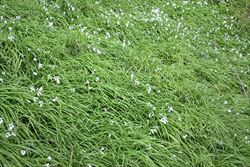
large infestation (Photo: Sheldon Navie)
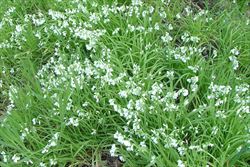
dense infestation in flower (Photo: Sheldon Navie)

habit (Photo: Sheldon Navie)

drooping, strap-like leaves (Photo: Sheldon Navie)

close-up of the three-angled flowering stem (Photo: Sheldon Navie)
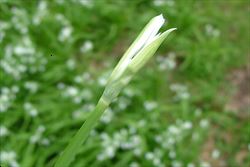
flower buds enclosed in two papery bracts (Photo: Sheldon Navie)
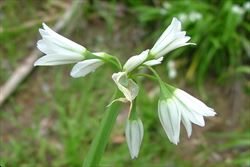
older flowers close and begin to droop (Photo: Sheldon Navie)

close-up of older flowers and immature fruit (Photo: Sheldon Navie)

the small onion-like bulbs (Photo: Sheldon Navie)
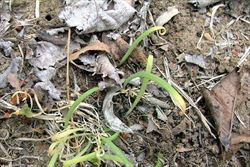
seedlings (Photo: Sheldon Navie)
Scientific Name
Allium triquetrum L.
Family
Alliaceae (Queensland, New South Wales, the ACT and Western Australia)Liliaceae (Victoria, Tasmania and South Australia)
Common Names
angled onion, flowering onion, onionweed, stinking onion, three corner garlic, three cornered garlic, three cornered leek, three-corner garlic, threecorner leek, three-cornered garlic, three-cornered leek, triangular stalked garlic, triquetrous garlic, triquetrous leek, white-flowered onion, wild onion
Origin
Native to north-western Africa (i.e. Algeria, Morocco and Tunisia), the Azores, the Madeira Islands and southern Europe (i.e. Italy, France and Spain).
Cultivation
This species was commonly cultivated as a garden ornamental, but it is not often deliberately cultivated these days.
Naturalised Distribution
A widely naturalised species that is most common in the southern parts of Australia. It is very common in Victoria, Tasmania, south-eastern South Australia and south-western Western Australia. Also scattered in the southern and eastern parts of New South Wales and occasionally naturalised in other parts of South Australia. Three-cornered garlic (Allium triquetrum ) was also naturalised in the cooler parts of south-eastern Queensland, but there have been no records in this region for many years.
Naturalised overseas in the UK, western USA (i.e. California and Oregon), tropical Asia and New Zealand.
Habitat
A weed of wetter temperate and cooler sub-tropical regions that favours shaded areas. It inhabits waterways and riparian areas, gardens, parks, footpaths, roadsides, waste areas, disturbed sites, orchards, open woodlands, forests and moist pastures.
Habit
A small, upright (i.e. erect), long-lived (i.e. perennial), herbaceous plant usually growing 18-50 cm tall. Its aboveground parts re-grow each autumn from an underground bulb and die back again during summer.
Distinguishing Features
- a small herbaceous plant (18-50 cm tall) re-growing each year from long-lived underground bulbs.
- its strap-like leaves and strongly three-angled stems give off a strong garlic smell when bruised or damaged.
- its white bell-shaped flowers are produced in small clusters at the top of stems.
- these flowers (about 15 mm long and 10-18 mm across) have six 'petals', each with a green stripe running down its middle.
- they droop towards the ground after flowering and the persistent 'petals' enclose the developing fruit.
Stems and Leaves
The slightly fleshy (i.e. semi-succulent) flowering stems grow up to 50 cm long, but are usually only 20-40 cm long. They are triangular in cross-section (i.e. triquetrous), green in colour, and hairless (i.e. glabrous). The stems and leaves give off a rather unpleasant onion-like or garlic-like odour when bruised or damaged.
The leaves are alternately arranged, but clustered towards the base of the stems. They are light green in colour with sheaths that enclose the lower part of the stems. These leaves (12-50 cm long and 3-20 mm wide) are soft, slightly fleshy (i.e. semi-succulent), and often drooping or weeping in nature. They are strap-like (i.e. linear) and have a 'keel' (i.e. prominent midrib) on their undersides. Their margins are entire and they are hairless (i.e. glabrous).
Flowers and Fruit
The flowers are borne in a cluster (3.5-7.5 cm across) at the tips of the stems (i.e. in a terminal umbel). Their buds are initially enclosed in two whitish-coloured papery bracts, which open to reveal a cluster of 3-15 bell-shaped (i.e. tubular) flowers. Each flower is borne on a stalk (i.e. pedicel) 10-25 mm long and they droop towards the ground after opening (i.e. they are pendulous). The flowers (10-15 mm long and 10-18 mm across) have six white 'petals' (i.e. tepals or perianth segments) that are fused together at the base. Each of these 'petals' (10-15 mm long) has a prominent green stripe running down its middle and a pointed or rounded tip (i.e. acute or obtuse apex). The flowers also have six yellow stamens (5-6 mm long) and an ovary topped with a stigma consisting of three short curved branches. Flowering occurs mostly during late winter and spring.
The fruit are rounded (i.e. globular) capsules that are initially green in colour. These capsules (4-7 mm across) turn light brown as they mature and contain several small black seeds (2-5 mm long) that are oblong in shape.
Reproduction and Dispersal
This plant reproduces by seed and also vegetatively by is long-lived bulbs. The small bulbs (5-20 mm across) are egg-shaped (i.e. ovoid) and white in colour. Their outer layers consist of the swollen bases of the leaf sheaths and numerous smaller bulbs (i.e. bulblets or bulbils) are produced from the base of these bulbs each year.
The bulbs and bulblets are spread when soil is moved or cultivated. Seeds may be dispersed by ants, water, in contaminated soil, or in dumped garden waste.
Environmental Impact
Three-cornered garlic (Allium triquetrum) is a significant environmental weed in Victoria, South Australia, Western Australia and Tasmania. This species invades a large number of vegetative formations in the temperate regions of Australia (e.g. dry coastal vegetation, lowland grasslands, grassy woodlands, dry sclerophyll forests, wet sclerophyll forest and freshwater wetlands), but is most prominent in wetter shady sites and areas near watercourses (i.e. in riparian vegetation).
It is known to have serious impacts on the natural habitats that it invades and is very aggressive, having the potential to rapidly occupy large tracts of land. Three-cornered garlic (Allium triquetrum) forms dense and persistent stands that totally dominate the ground-flora when conditions are suitable. These stands crowd out and displace the indigenous grasses and groundcovers and can also seriously impede the regeneration of the over-storey vegetation.
Three-cornered garlic (Allium triquetrum) is probably most widespread in Victoria, where it is regarded as a very serious threat to one or more vegetation formations. It appears very prominently on a plethora of local and regional environmental weed lists in this state (e.g. in Monash City, Knox City, Banyule City, Sherbrooke Forest, Kananook Creek, the Shire of Yarra Ranges, Nillumbik Shire, the Surf Coast Shire, Mitchell Shire, Geelong City, Manningham City, Kingston City, Corangamite Shire, Mornington Peninsula Shire, Colac-Otway Shire, the Goulburn Broken Catchment and the Bendigo region).
It is also a common environmental weed of the Adelaide region in south-eastern South Australia and has been recorded in several conservation areas in this state (e.g. in Marino Conservation Park, Sturt Gorge Recreation Park, Onkaparinga National Park, Belair Reserve, Belair National Park, Anstey Hill Recreation Park and Cleland Conservation Park).
This species favours moist soils around creeklines and granite rocks in south-western Western Australia, and is regarded as a potentially very serious bushland weed in this state. It was given a moderately high priority ranking in the recent Environmental Weed Strategy of Western Australia. In Tasmania, three-cornered garlic (Allium triquetrum) is a common weed of coastal environs and grasslands in the north-western and southern parts of the state. This species is also invasive along creeks in the Sydney region, in New South Wales, and is listed as an environmental weed in the wider Sydney and Blue Mountains region.
Other Impacts
Three-cornered garlic (Allium triquetrum) can also taint milk and meat, however stock tend to avoid it due to its onion-like flavour. Hence, when growing in pastures, it can significantly reduce the productivity of heavily invaded areas.
Legislation
This species is declared under legislation in the following states and territories:
- South Australia: 7* - this species is declared under Class 7c, which is a classification for localised pest plants. It is declared in the Barossa Ranges and Mount Lofty Ranges, and control is only required in those areas.
- Victoria: C2 - a regionally controlled weed in the Corangamite and Port Phillip East regions, where landholders must take all reasonable steps to control it and prevent its spread on their land and the roadsides which adjoin their land.
- Western Australia: Unassessed - this species is declared in other states or territories and is prohibited until assessed via a weed risk assessment (throughout the entire state).
Management
For information on the management of this species see the following resources:
- the Victorian Department of Natural Resources and Environment Coastal Note on this species, which is available online at http://www.dpi.vic.gov.au.
- the Shire of Yarra Ranges Environmental Weed Fact Sheet on this species, which is available online at http://www.yarraranges.vic.gov.au.
Similar Species
Three-cornered garlic (Allium triquetrum) may be confused with crow garlic (Allium vineale), wild onion (Nothoscordum borbonicum), onion weed (Asphodelus fistulosus), dune onion weed (Trachyandra divaricata) and snowdrops (Leucojum aestivum). These species can be distinguished by the following differences:
- three-cornered garlic (Allium triquetrum) has flattened, strap-like, leaves and produces drooping flowers that are borne in small, loose clusters at the top of its three-angled (i.e. triquetrous), unbranched stems. These flowers have a prominent green stripe running down the middle of each 'petal' (i.e. perianth segment).
- crow garlic (Allium vineale) has cylindrical, hollow, leaves and produces dense clusters of flowers and/or 'bulbils' at the top of its cylindrical, unbranched stems. These flowers are white, pinkish, or greenish in colour and do not have a green stripe running down the middle of each 'petal' (i.e. perianth segment).
- onion weed (Nothoscordum borbonicum) has flattened, strap-like, leaves and produces upright flowers that are borne in clusters at the top of its cylindrical, unbranched stems. These flowers sometimes have a pale reddish or greenish-coloured stripe running down the outside of each 'petal' (i.e. perianth segment).
- onion weed (Asphodelus fistulosus) has cylindrical, hollow, leaves and produces flowers that are borne along its cylindrical, few-branched stems. These flowers have a prominent reddish stripe running down the middle of each 'petal' (i.e. perianth segment).
- dune onion weed (Trachyandra divaricata) has flattened, hollow, leaves and produces flowers that are borne towards the ends of its cylindrical, much-branched stems. These flowers have a prominent reddish stripe running down the middle of each 'petal' (i.e. perianth segment).
- snowdrops (Leucojum aestivum) has flattened, strap-like, leaves and produces drooping flowers that are borne in clusters at the top of its cylindrical, unbranched stems. These flowers are white with small green spots on the tips of their 'petals' (i.e. perianth segments).
Native species such as milkmaids (Burchardia umbellata and Burchardia congesta), garland lily (Calostemma purpureum) and vanilla lily (Sowerbaea laxiflora) may also be confused with three-cornered garlic (Allium triquetrum). However, these species don't smell like garlic and do not have any green stripes on their petals. The petals of milkmaids (Burchardia umbellata and Burchardia congesta) are entirely white, while those of garland lily (Calostemma purpureum) and vanilla lily (Sowerbaea laxiflora) are pink or purple in colour.

